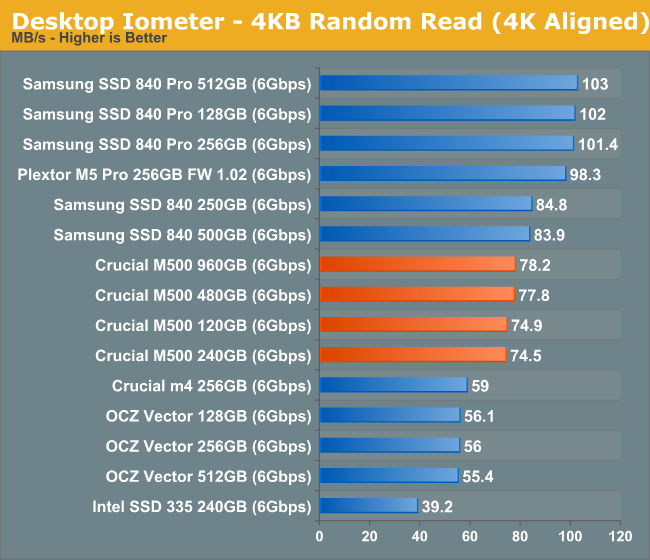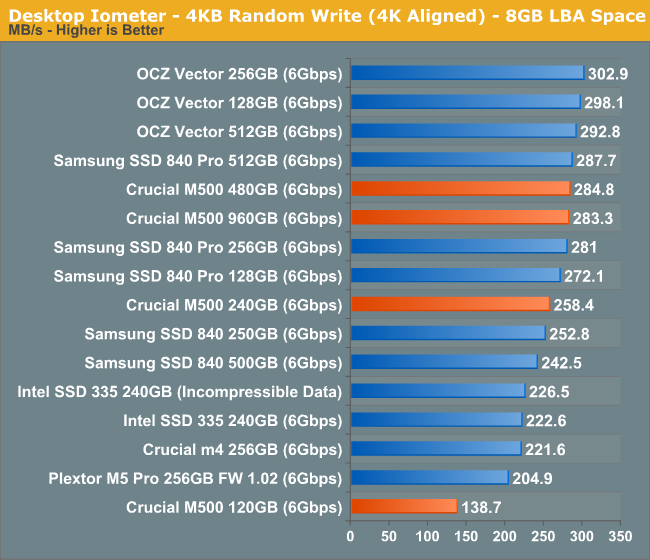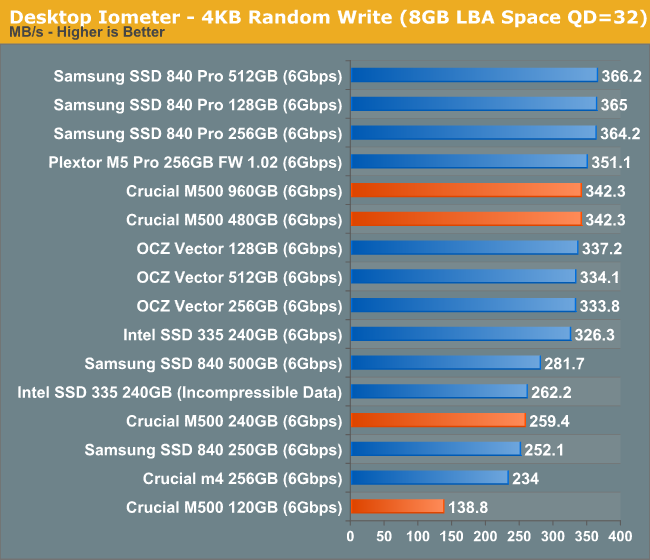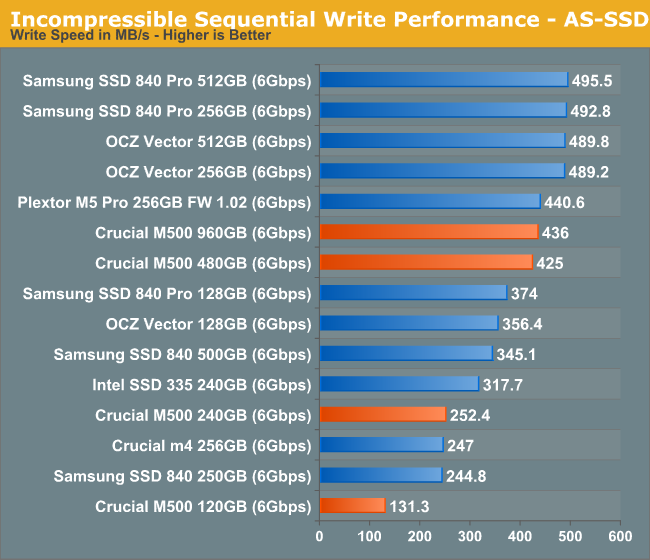The Crucial/Micron M500 Review (960GB, 480GB, 240GB, 120GB)
by Anand Lal Shimpi on April 9, 2013 9:59 AM ESTRandom Read/Write Speed
The four corners of SSD performance are as follows: random read, random write, sequential read and sequential write speed. Random accesses are generally small in size, while sequential accesses tend to be larger and thus we have the four Iometer tests we use in all of our reviews.
Our first test writes 4KB in a completely random pattern over an 8GB space of the drive to simulate the sort of random access that you'd see on an OS drive (even this is more stressful than a normal desktop user would see). I perform three concurrent IOs and run the test for 3 minutes. The results reported are in average MB/s over the entire time. We use both standard pseudo randomly generated data for each write as well as fully random data to show you both the maximum and minimum performance offered by SandForce based drives in these tests. The average performance of SF drives will likely be somewhere in between the two values for each drive you see in the graphs. For an understanding of why this matters, read our original SandForce article.

Random read performance starts out quite nicely. There's a good improvement over the old m4 and the M500 lineup finds itself hot on the heels of the Samsung SSD 840. There's not much variance between the various capacities here.

It's with the random write performance that we get some insight into how write parallelism works on the M500. The 480GB and 960GB drives deliver roughly the same performance, so all you really need to saturate the 9187 is 32 NAND die. The 240GB sees a slight drop in performance, but the 120GB version with only 8 NAND die sees the biggest performance drop. This is exactly why we don't see a 64GB M500 at launch using 128Gbit die.

Ramping up queue depth causes some extra scaling on the 32/64 die drives, but the 240GB and 120GB parts are already at their limits. There physically aren't enough NAND die to see any tangible gains in performance between high and low queue depths here on the smaller drives. This is going to be a problem that everyone will have to deal with ultimately, the M500 just encounters it first.
Sequential Read/Write Speed
To measure sequential performance I ran a 1 minute long 128KB sequential test over the entire span of the drive at a queue depth of 1. The results reported are in average MB/s over the entire test length.

Low queue depth sequential read performance looks ok but the M500 is definitely not class leading here.

There's pretty much the same story when we look at sequential writes, although once again the 120GB M500 shows its limits very openly. The 840 and M500 have similar performance levels at the same capacity point, but the M500 is significantly behind the higher end offerings as you'd expect.
AS-SSD Incompressible Sequential Read/Write Performance
The AS-SSD sequential benchmark uses incompressible data for all of its transfers. The result is a pretty big reduction in sequential write speed on SandForce based controllers.

Ramping up queue depth we see a substantial increase in sequential read performance, but there's still a big delta between the M500 and all of the earlier drives.

The high-queue depth sequential write story is a bit better for the M500. It's tangibly quicker than the 840 here.










111 Comments
View All Comments
gochichi - Wednesday, April 10, 2013 - link
Crucial is in a unique position. I don't think people care about performance numbers. What we know is that SSD s are either a nightmare or a dream. What we want is a dream. People want simple understandable marketing.My favorite SSD so far is a Monster Digital 240gb Daytona. It has been absolutely flawless. But the 120 gb version is a lemon. Reselling the drive would never happen. Monster Digital is probably not going to be a player in the SSD market going forward.
My point is, what's at stake here is who's the next Seagate? The next Western Digital? Of SSDs. Samsung can do no wrong, much like Apple. And yet this weird little company called Crucial has enjoyed tremendous on-the-street notoriety with their M4 series.
As far as I can tell the M4 is a little outdated. My question is why not release an M5? Why 500? Why waste so much consumer goodwill? Is it just that this drive isn't good? Or not good enough for proper successorship?
I don't know why I've purchased crucial drives before, it started with a little 64gb m4. The I just trust the m4 line. My point is why does Crucial carry bad models and why so many confusing numbers? The m4 is a golden opropportunity. Where's that trusty m5 follow up? Samsung has understandable generations and model lines. They're making sure they're the Western Digital of SSD. Why isn't Crucial doing similar?
Solid State Brain - Wednesday, April 10, 2013 - link
The reason why it's M500 and not M5 is probably because of Plextor:http://www.plextor-digital.com/index.php/en/M5-Pro...
Kristian Vättö - Thursday, April 11, 2013 - link
Crucial isn't exactly small, they are a subsidiary of Micron. As said above, Plextor has M5S and M5 Pro SSDs so M5 would have been very confusing, hence the M500. The OEM version of M4 was C400, so it's actually not that confusing.FunBunny2 - Thursday, April 11, 2013 - link
-- My point is, what's at stake here is who's the next Seagate? The next Western Digital? Of SSDs.Getting harder to say. The three well known public companies doing SSD (mostly) as such, STEC, OCZ, Fusion-io, have been missing all targets for a least a couple of quarters. Violin may or may not IPO in the next few months.
The reasonable answer is that there won't be a Seagate or WDC for SSD. It's well understood how to take commodity HDD to Enterprise Drive, using tighter QA and some incrementally better parts at modest cost. With SSD, as this review shows, "progress" in feature shrink isn't improving any of the factors at lower cost. It is quite perverse. The NAND suppliers will come to dominate consumer SSD, with performance asymptotically approaching a bit better than current HDD, with a price premium. Look for TLC, with huge erase blocks, long latencies, slowing controllers (having to do all that much more work to get around the NAND).
Enterprise SSD will likely fade away, to be replaced by NAND arrays, along the line of the Sun/Oracle device, which has been around for a few years.
dilidolo - Wednesday, April 10, 2013 - link
Everyone else mentioned Super Cap in M500 but not here. I just want to confirm if it's true.Tjalve - Friday, April 12, 2013 - link
Therte seems to be capacitors on the drive. But i would like to know aswell.klmccaughey - Thursday, April 11, 2013 - link
The pricing is WAY off. £274 ($420) for 240GB one in the UK!!! They must be mad.philipma1957 - Friday, April 12, 2013 - link
the 960gb was 570 usd at amazon. at your price x 4 it would be $1680. that is a lot of value tax.philipma1957 - Friday, April 12, 2013 - link
I just went on amazon uk the 240gb is 168 pounds the 480gb is 321 pounds. some what better. then the price you foundKarol Bulova - Saturday, April 13, 2013 - link
I own Samsung 840Pro (it had cash-back recently) so I welcome this comments from articles on Anandtech.'The 840 Pro does an amazing job with 25% additional spare area however, something that can't be said for the M500. '
'if you simply set aside 25% of the total NAND capacity as spare area' performance improves'
I am running Win8 64bit with TRIM enabled - what is unclear for me though, is:
1. is spare are just free not occupied space on the HDD (e.g. when it is not full)
2. or is it just un-formatted partition (without a filesystem - thus no files expect for header)
3. or there shouldn't be any partition at all - and drive will somehow figure it up that I just magically allocated spare area
Or is there some utility for Samsung to do spare area? Please advice - from what I understand I should reinstall windows and choose 192GB as my main drive capacity instead of full!